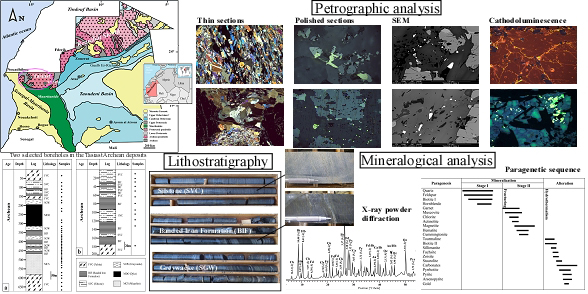Petrography and mineralogical study of gold mineralization in the Tasiast Archean deposits (Mauritania)
DOI:
https://doi.org/10.13133/2239-1002/18697Abstract
This study aims to determine the mineral phases containing gold mineralization and other mineral indicators in two prominent deposits (West Branch and Piment) in Tasiast. This latter area is one of the major areas of the Reguibat Shield and is primarily composed of Mesoarchean rocks from the Aoueouat greenstone belt. In addition, the West Branch is hosted in meta-igneous rocks, whereas Piment is situated within meta- sedimentary rocks. The results of 55 samples collected from the cores of two boreholes show that the crossed series is composed by rocks of the types felsite (FVC), greywacke (SGW), siltstone (SVC), micaschist (MCS) and banded iron formation (BIF). Petrographic observations via polished and thin sections, scanning electron microscopy (SEM) and cathodoluminescence (CL) confirmed by mineralogical results were performed by means X-ray diffraction (XRD), revealed that the genesis of gold deposits in both boreholes was linked mainly to hydrothermal activity.
The minerals associated with the hydrothermal deposits are biotite, muscovite, fuchsite, zoisite, staurolite, chlorite, cummingtonite, tourmaline, hornblende and garnet. They are present in variable proportions in the crossed rocks, which suffered a high degree of metamorphism. On the other hand, the genesis of gold is mostly linked to hydrothermal activity. In fact, this mineral is associated mainly with sulfides such as pyrrhotite and occasionally appears as inclusions inside pyrite and arsenopyrite. Therefore, the hydrothermal system that generated the gold mineralization was likely active under brittle and ductile deformation conditions after mild metamorphism.

Downloads
Published
Issue
Section
License
Copyright (c) 2025 Periodico di Mineralogia

This work is licensed under a Creative Commons Attribution 4.0 International License.

